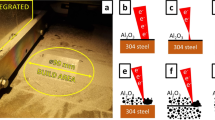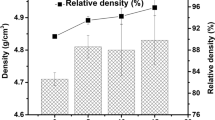Technological conditions for preparing ceramics based on MoSi2 hardened by SiC and ZrB2 that have enhanced physicomechanical properties (relative density ≥99.1%, bending strength 480 MPa) were experimentally investigated. The developed composites could be recommended for the creation based on them of functional structural ceramics operating at elevated temperatures in an oxidizing environment.



Similar content being viewed by others
References
T. Ya. Kosolapova (ed.), Properties, Preparation and Application of Refractories: Handbook [in Russian], Metallurgiya, Moscow, 1986, 928 pp.
S. Lohfeld, M. Schutze, A. Bohm, et al., “Oxidation behaviour of particle reinforced MoSi2 composites at temperatures up to 1700°C. Part III: Oxidation behaviour of optimised MoSi2 composites,” Mater. Corros., 56(4), 250 – 258 (2005).
Gang Wang, Wan Jiang, Guangzhao Bai, and Libin Wu, “Effect of addition of oxides on low-temperature oxidation of molybdenum disilicide,” J. Am. Ceram. Soc., 86(4), 731 – 734 (2003).
A. K. Vasudevan and J. J. Petrovic, “A comparative overview of molybdenum disilicide composites,” in: Papers of the 1st High Temperature Structural Silicides Workshop, Gaithersburg, ML [sic], USA, Nov. 4 – 6, 1991, No. 1/2, pp. 1 – 17.
M. J. Maloney and R. J. Hecht, “Development of continuous-fiber-reinforced MoSi2-base composites,” Mater. Sci. Eng., A, 155, 19 – 31 (1992).
S. L. Shikunov and V. N. Kurlov, “SiC-based composite materials obtained by siliconizing carbon matrices,” Zh. Tekh. Fiz., 87(12), 1871 – 1878 (2017).
C. M. Huang, C. Y. Yuh, M. Farooque, et al., “Properties and microstructure of molybdenum disilicide–β′;-SiAlON particulate ceramic composites,” J. Am. Ceram. Soc., No. 11, 2837 – 2843 (1997).
J. J. Petrovic, R. E. Honnell, and W. S. Gibbs, US Pat. 5,069,841, “Molybdenum disilicide alloy matrix composite,” Dec. 3, 1991.
S. S. Ordan’yan, A. I. Dmitriev, and E. S. Moroshkina, “Reaction of SiC with ZrB2,” Izv. Akad. Nauk SSSR, Neorg. Mater., 25(10), 1752 – 1754 (1989).
S. S. Ordan’yan, S. V. Vikhman, S. A. Larentseva, and V. V. Smirnov, “Structure of the section SiC–MoSi2 in the system Mo–Si–C,” Ogneupory Tekh. Keram., No. 11, 2 – 4 (2006).
S. S. Ordan’yan, “Common aspects of phase relations in SiC–MeIV/VB2 systems,” Zh. Prikl. Khim., 66(11), 2439 – 2444 (1993).
Experiments were performed on equipment at the Common Use Center Composition, Structure, and Properties of Structural and Functional Materials, Prometei CRSI of Structural Materials, Kurchatov Institute SRC, with financial support from the Ministry of Education and Science in the framework of contract No. 14.595.21.0004, unique identifier RFMEFI 59517X0004.
Author information
Authors and Affiliations
Corresponding author
Additional information
Translated from Novye Ogneupory, No. 8, pp. 34 – 37, August, 2019.
Rights and permissions
About this article
Cite this article
Markov, M.A., Ordan’yan, S.S., Vikhman, S.V. et al. Preparation of MoSi2–SiC–ZrB2 Structural Ceramics by Free Sintering. Refract Ind Ceram 60, 385–388 (2019). https://doi.org/10.1007/s11148-019-00372-4
Received:
Published:
Issue Date:
DOI: https://doi.org/10.1007/s11148-019-00372-4




